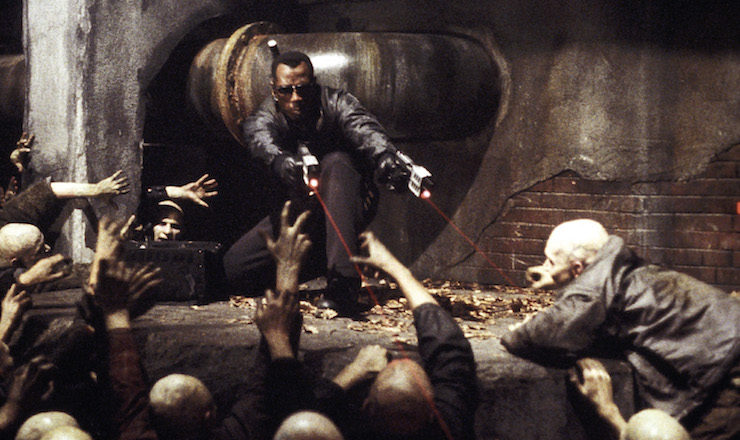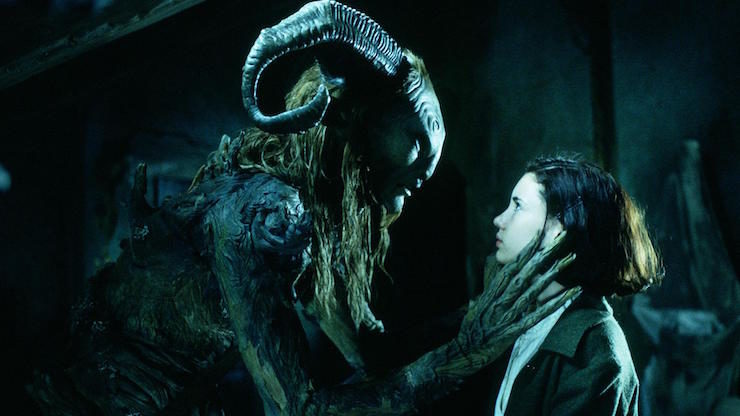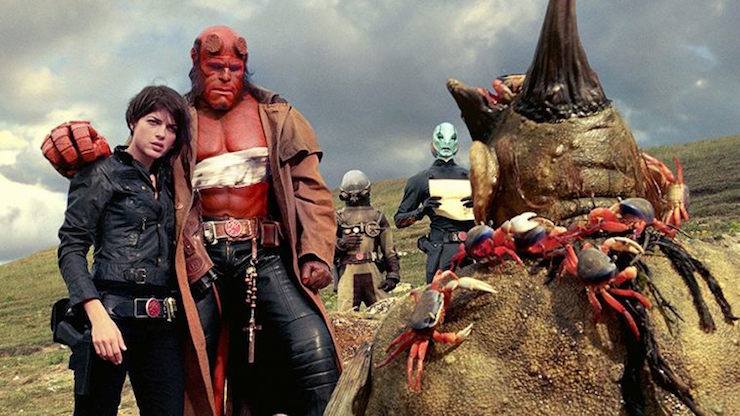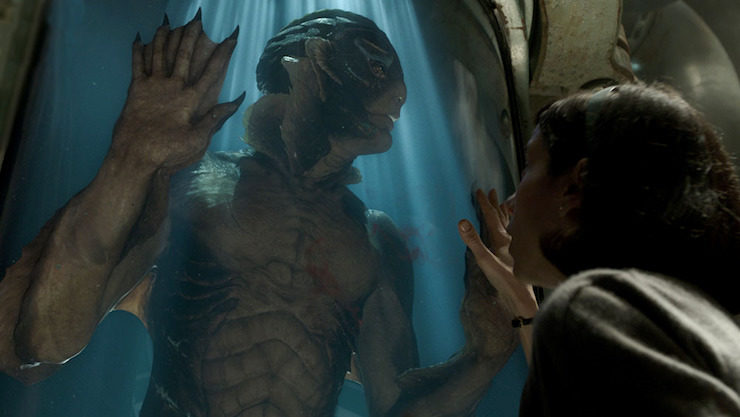Let’s hear it for Guillermo del Toro, ladies and gentlemen! One of the most passionate and articulate advocates for genre (in particular) and narrative (in general) as a force for good finally picked up a long overdue best Director Oscar earlier this month. His prolific body of work is filled with movies that are worth your time, so if you’re looking for where to go next in his filmography (or just in need of some excellent rewatch options), here are some suggestions…
Mimic, on its initial release, got somewhat lost in the vast wave of mid-range horror and science fiction that hit cinemas in the early ‘90s. It was also a film that del Toro was unhappy with, as he did not have final cut. That was remedied by the release of a director’s cut released in 2011, which helps the film immensely.

The movie, based on the short story by Donald A. Wollheim, is set in a vaguely post-apocalyptic New York still reeling from an outbreak of Strickler’s Disease that killed hundreds of the city’s children. Doctor Susan Tyler (an always excellent Mira Sorvino) saved the city by creating “the Judas breed,” an insect that releases an enzyme which accelerates the metabolism of the cockroaches that were spreading Strickler’s. (Still with me? Great!) The Judas breed was itself a biological time bomb, designed as a single gender species so that it would die off once its job was done.
Three years later, a pair of children find a weird bug in the subway and sell it to Susan. The bug shows that the Judas breed hasn’t merely survived: it’s evolved…
The film presents us with a New York rendered into a sick sodium green nightmare, a city jutting up from the bones of its past, not caring what those bones are coated in. Del Toro’s love for earthy, urban environments shines through, as does his ability to find profound beauty in the alien. The big reveals here are all delivered as gut punches, and if you find insects unsettling then this is both a must-watch and a hide-behind-the-couch-at-regular-intervals movie. Josh Brolin, Jeremy Northam and Charles S. Dutton all do excellent work, as does Norman Reedus, and of course, del Toro’s muse, Doug Jones. But this is Sorvino’s movie all the way down. Susan Tyler is a spiritual daughter of Ellen Ripley: an endlessly competent, driven, complex, and relatable lead and every one of the movie’s best moments are hers. To this day, her delivery of the line, “Peter, these are LUNGS…” chills me to the bone.

If Mimic was del Toro’s entry into Hollywood, Blade II was his spotlit debut. It is, on the one hand, a brilliant expansion of the world of the first movie; Blade is forced to work with a group of vampire mercenaries, joining forced to protect the world against the next stage in vampiric evolution. There’s some fascinating detail about vampire society, the mercenaries themselves are a fun time (Ron Perlman especially), and the whole film looks flat-out gorgeous.
But on the other hand, it’s the least interesting English-language movie del Toro’s turned in to date. Part of that is because it’s the middle chapter of a franchise, one that was being put together on the fly instead of being built around the kind of existing architecture that is central to what makes the MCU work. The rest is an early illustration of del Toro’s signature bad luck. The film throws a ton CGI up on the screen at the worst possible time to do so, and many fight scenes lose their physicality as a result. Some major cast members are either given little to do or do little with what they have, and, infamously, the film is the subject of what has been called the worst written movie review in history (I should note that the language in said review is definitely NSFW.) Blade II is never less than diverting, but unfortunately it’s also never becomes much more than that.

Pan’s Labyrinth, however, is one of the best horror movies ever made. It’s also not entirely a horror movie, mixing fairy tales and fables with established history to create a film where the reality of everything we see is slippery and uncertain. Ofelia is a young girl in post-civil war Spain, sent to live with her new stepfather, Captain Vidal. But when she starts to see things that aren’t there, Ofelia is drawn into the world beneath the world and discovers that she may be facing a destiny—and dangers—greater than she’d ever imagined…
Pan’s Labyrinth is an extraordinary movie that explores at length the idea of escapism as a survival mechanism. That psychological labyrinth mirrors the one at the heart of the movie, and del Toro’s delicacy of touch ensures that as reality begins to fall away, we’re no longer sure whether we really want to know the truth of Ofelia’s story. There’s an almost Terry Gilliamesque quality to some of the work here, but with none of Gilliam’s tendency to get carried away. Instead, in the fiercely great Ivana Baquero as Ofelia and two iconic performances from Doug Jones, del Toro gives the movie the anchors it needs to become something truly otherworldly. If you see only one of the director’s movies from this list, make it this one.

Hellboy and Hellboy II: The Golden Army are the definitive mainstream Hollywood del Toro movies. (Or they were, until the Academy officially welcomed The Shape of Water into the pantheon). Based on the era-defining Mike Mignola comic series, they follow the exploits of a young boy recovered from an occult ritual held during the closing stages of World War II. He’s red, has horns, and his right hand is made of stone. His name is Hellboy, and he will grow up to either save the world or end it. Perhaps both.
These movies are both a joy and a tragedy. The joy springs from the fact that del Toro is a perfect fit for this world. He renders Hellboy’s foes as chthonic and menacing but very real, and the world they threaten is recognisably ours, but subtly stranger and under siege. Best of all, he has a profound understanding of the humanity of these characters. Perlman’s Hellboy is a career-best moment, all adolescent bluster and adult physicality. He’s grumpy, incompetent, brave, tender and more—often in the same scene, and Perlman, one of the greatest actors of our time, is never better than he is here. Doug Jones, Selma Blair, and all the rest of the cast are also impressive as they sprint through the glorious clockwork nightmares of del Toro’s brain.
The tragedy comes from the knowledge that these films were designed as a trilogy, and its one that will never be completed. Cult classics but relatively small commercial successes, they have never really faded from fan consciousness, but they’ve also never registered much in the mainstream. As a result, the series is now being rebooted with Dog Soldiers and Game of Thrones director Neil Marshall in the director’s chair and David Harbour of Stranger Things under the horns and makeup. Early signs are promising, but the shadow that del Toro’s unmade Hellboy 3 casts is still very, very long. As a result, these films are glorious, muscular pieces of mainstream horror cinema that will forever contain the unfulfilled promise of something even greater.

Next up, Pacific Rim. PUNCH THE GIANT MONSTER IN THE FAAAAAAAAAAAAACE!!!
My profound love for this movie is a matter of public record. For those of you who haven’t seen it, I honestly envy you—it is such a good time. The premise is glorious: a rift has opened in the Pacific sea bed. Colossal monsters swim through it and decimate coastal cities the world over. We’re being invaded. We’re losing.
So we build titanic, two-piloted mech suits to beat the monsters to death.
Fun as this is, there is also so much more to the movie. Idris Elba’s magnificently named Stacker Pentecost is a fascinating study in the doctrine of dying the Good Death, while Rinko Kikuchi’s Mako Mori remains one of the most quietly compelling female leads in genre history. There is a dog who is ludicrously adorable. Genre stalwarts Max Martini and Rob Kosinski show up as father and son. The idea of the Drift, the shared brain-space pilots use to move their Jaeger mechs, is fascinating and flat-out brilliant. There’s a brilliant fan reading that gives the conflict between Herc and Chuck Hansen a massively complex background, which the movie provides circumstantial evidence for. There’s a chaste-yet-intimate friendship at the heart of the movie. Also, the best theme song of the last two decades. ELBOW ROCKETS. GIANT MONSTERS. The list goes on and one… This is del Toro the anime fan let loose in a box of amazing toys, and the results are incredibly enjoyable. See it. And then you can also listen to the excellent School of Movies and friends (including me), talk about it.

Finally, Crimson Peak is del Toro’s most recent film before The Shape of Water and one of his most interesting. CA Yates, in the essay “‘A Monstruous Love’: Crimson Peak and the Writer,” breaks down the movie’s extraordinary approach to story and gender more effectively than I could ever hope to, and that piece is a must-read once you’ve seen the movie.
Crimson Peak follows writer Edith Cushing as she falls for Thomas Sharpe and marries him. As she moves into his decaying English mansion, built on the red clay deposits that have made his family’s name, she comes into conflict with Lucille, Sharpe’s sister, and the dark secrets the house holds…
Crimson Peak takes del Toro’s frequent themes of decay and urban blight and internalises them, concentrating them down to a single house. Here the ghosts are like insects, always present, usually invisible. The bones of the past become the literal bones of unwitting victims, and the shifting, collapsing house becomes the embodiment of the lives all three inhabitants, showcasing just how fragile and precarious they are. Starkly beautiful, and lush like a box of immaculate, potentially poisoned truffles, Crimson Peak, like Pacific Rim and The Shape of Water, is del Toro at his most essential. See it for Tom Hiddleston; stay for Mia Wasikowska with an axe and Jessica Chastain having the sinister time of her life.
Something horrifying growing beneath the streets of New York. The mutated apex predator that could topple the vampire and destroy humanity. Fairy tales as a survival mechanism. The world’s greatest, but least subtle, occult detective. A rip-roaring salute to mecha and kaiju stories. A ghost story where nothing is what it seems, and a bewitching romance between a woman and a monster. Guillermo del Toro’s stories all appear big but are all, at their heart, small and intimate. An extraordinary director who embraces and learns from his art constantly, it’s a true pleasure to see him honoured and at the top of his game. And, as ever, I can’t wait to see what he does next.
Alasdair Stuart is a freelancer writer, RPG writer and podcaster. He owns Escape Artists, who publish the short fiction podcasts Escape Pod, Pseudopod, Podcastle, Cast of Wonders, and the magazine Mothership Zeta. He blogs enthusiastically about pop culture, cooking and exercise at Alasdairstuart.com, and tweets @AlasdairStuart.










